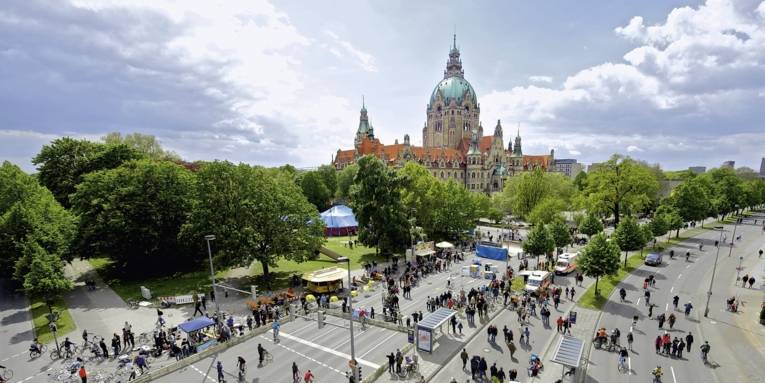Hannover – the natural choice

Autofreier Sonntag / Car Free Sunday
The green city
Urban vitality and environment friendliness go hand in hand in the capital city of Lower Saxony. Hannover is in fact Germany’s greenest city, as almost half the surface area consists of greenery. In 2011, it even won the title “German Capital of Biodiversity”, an accolade resulting from numerous campaigns aimed at creating “More Nature in the City”. Some 8,000 more trees than 20 years ago now line the streets of Hannover. The city’s green lung Eilenriede Forest alone covers an area of 1,600 acres, making it almost twice the size of New York’s Central Park. This urban woodland area is just one of the many natural habitats and recreational areas close to the city. Maschsee Lake is an eldorado for water sports fans, joggers, skaters and those who simply enjoy a good long walk. Other green areas such as Operndreieck or the City Park, a unique horticultural ensemble, are right in the centre of town. Many people who live in Hannover have an allotment as their own private nature retreat. All in all there are more than 20,000 plots in 270 different allotment associations throughout the city.
Pioneering climate protection
Back in 2008, Hannover was the first city in Germany to launch a climate protection programme. Entitled Climate Alliance Hannover 2020, the programme’s objective for the year 2020 is to reduce carbon emissions from electricity and heat consumption by 40 per cent compared with the 1990 level. One visible sign of this ambitious target is the zero:e park, the largest zeroemission housing scheme anywhere in Europe. Around 300 terraced, detached and semidetached houses will be built in the Wettbergen district as passive houses, in which the residents consume approx. 80 per cent less energy than the legally prescribed level for new buildings. The Hannover-Kinder-Bauland bonus scheme awards private housebuilding grants to families with children in an urban environment, proving that saving our natural resources and subsidising affordable housing need not be contradictory. The enercity proKlima subsidy programme, which involves funds of up to five million euros per annum, was launched as early as 1998 to promote climate protection in private households, business premises and public buildings. Hannover’s mobility concepts also revolve around sustainable energy savings and improving air quality. The light rail vehicles and buses operated by üstra Hannoversche Verkehrsbetriebe AG made this the first German transport company to fulfil EMAS standards. One good example is the HannoverMobilCard, which combines a conventional season ticket for local public transport with other mobility services such as car sharing, a Deutsche Bahn railcard and a wide range of services for cyclists. Once a year, the city stages a “car-free Sunday”, when Hannover’s population proves that protecting the climate can also be good fun: some 100,000 visitors converge on the city and numerous institutions provide information about modern mobility and climate protection.

 Deutsch
Deutsch
 English
English
 中文
中文
 Danish
Danish
 Eesti
Eesti
 Español
Español
 Suomi
Suomi
 Français
Français
 Italiano
Italiano
 日本語
日本語
 한국
한국
 Nederlands
Nederlands
 Norge
Norge
 Polski
Polski
 Portugues
Portugues
 Русский
Русский
 Svenska
Svenska
 Türkçe
Türkçe
 العربية
العربية
 Romanesc
Romanesc
 български
български